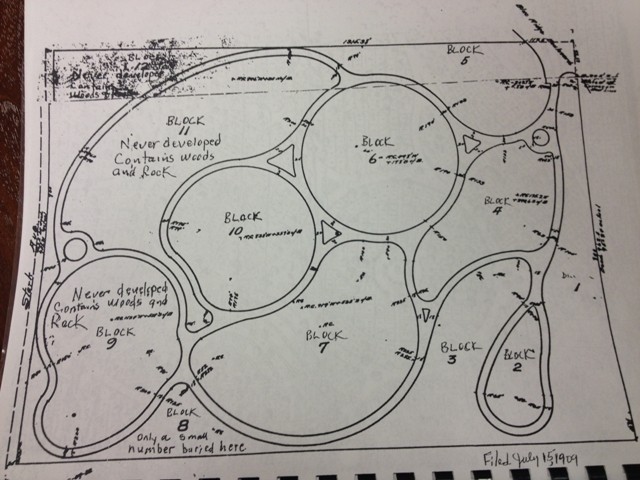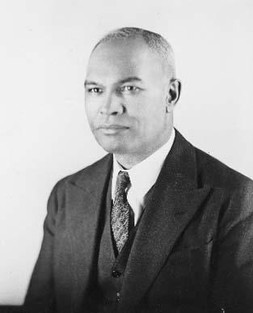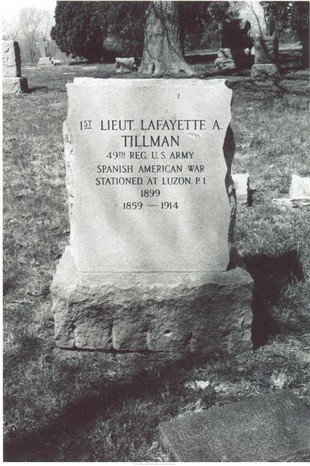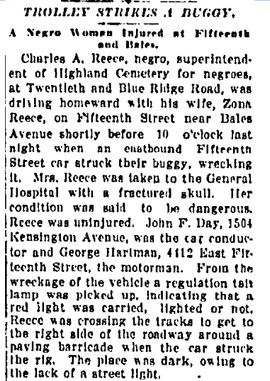This entry includes a walking tour! Take the tour.
Introduction
Text-to-speech Audio
For close to six decades, Highland Cemetery served as one of three private cemeteries open to African Americans in Kansas City. Established in 1909, it became the final resting place for more than 11,000 people before 1950. Among them were Bennie Moten, the famous jazz pianist; civil rights activist Daniel Arthur Holmes; granddaughter of Frederick Douglass, Fredericka Douglass Prague Sperry; and thousands more. When, in 1964, segregated cemeteries were made illegal, the resources that had maintained Highland Cemetery (through payment for burials) flowed instead to previously white cemeteries. Highland Cemetery fell into disrepair, though recent efforts by local students have attempted to clean up the cemetery and honor the many people interred there.
Images
The cemetery chapel as it appeared in 1915

A map of the cemetery from Find-A-Grave

Chester A. Franklin, owner of the Kansas City Call, a prominent African American newspaper, is buried in Highland Cemetery.

Lafayette A. Tillman, one of the first African Americans appointed to the Kansas City police force, is buried in Highland Cemetery.

Newspaper article about a buggy crash involving Charles A. Reece and Zonia Reece. Charles Reece was an early sexton of the cemetery.

Backstory and Context
Text-to-speech Audio
On February 12, 1909, the Highland Cemetery Company purchased a 29-acre tract of land on the outskirts of Kansas City from John and Frances Eames. The land cost $15,000. [1] Several months later, Sallie Powell was buried in Highland Cemetery, becoming the first person interred there. [2] In the cemetery’s landscaping and the layout of its curved roads, it was similar to many other early-twentieth century cemeteries, which were known as “perpetual care” cemeteries because they required constant maintenance, from tending gravestones to mowing grass to caring for other forms of vegetation, and therefore needed enough income to support this steady upkeep. But Highland Cemetery was different from other Kansas City cemeteries in one critical way: at the time it was built, it was the only private cemetery open to African American people. By 1964, when legal segregation in Kansas City came to an end, it was one of three cemeteries to serve the area’s Black population.
In the early 1900s, the cemetery flourished. Charles A. Reece served as an early sexton. [3] Between 1909 and 1950, more than 11,000 people were buried there. [4] Among them were civil rights activists, community leaders, newspaper owners, jazz singers, cooks, veterans, teachers, and deliverypeople. For many of their families, buying a gravesite and burying a relative or friend was not only emotionally devastating, but also financially challenging. African American churches helped defray funeral and burial costs with burial societies, in addition to more general forms of economic support and solidarity.
With the end of segregated cemeteries, fewer and fewer people were buried at Highland, which was also running out of room—and money. The funds that churches raised to pay for burials often went to previously all-white cemeteries as more of their congregants were buried there.
Every so often, however, someone would want to be buried near family. They would call on Bill Enloe, a gravedigger who started work when he was 12 years old, around 1950. Enloe had taken care of the cemetery for decades, laboring—quite literally—under the impression that he owned part of the land. What paperwork there was to document his ownership is gone, and the cemetery is now owned by the Land Trust of Jackson County, which took over the property when it fell behind on taxes. Taxes weren’t the only thing the cemetery could no longer afford: the constant upkeep needed to maintain the cemetery cost money, too. The cemetery became overgrown and run-down. In 2014, a journalist said of it, “People dump trash nearby. Tombstones sit cockeyed, and stray cats run about the brush. The roads through Highland Cemetery are gutted, and dead limbs hang from trees.” [5]
Recently, inspired by news coverage of the cemetery’s dilapidated condition, students from local schools worked to clean up the cemetery, scrubbing tombstones with toothbrushes and weed whacking grass that grew higher than their heads. [6] Here are some of the names they may have come across:
- Fredericka Douglass Sprague Perry, granddaughter of Frederick Douglass. Perry taught home economics at Lincoln High School before founding the Colored Big Sister Home for Girls to care for at-risk African American girls. These young people otherwise would have been sent to institutions for juvenile delinquents: at the time, the local orphanage released girls at age 12, and while homes were found for white girls, the same was not true for Black girls. [7]
- William “Pat” Patrick, who in 1920 was “the only official bartender the Kansas City Club ever had in the thirty-six years of its existence.” The Kansas City Club was an all-white gentlemen’s club founded in the nineteenth century. Though visitors to the club, according to the notice of his death published in the Kansas City Star, thought Patrick was perhaps a “Spaniard or Italian,” he was neither, and he was buried in Highland Park in March 1920. [8]
- Bennie Moten, a renowned jazz pianist and bandleader who contributed to the distinctive sound of Kansas City jazz until his death in 1935.
Sources
- Sally F. Schwenk, “Cultural Resource Survey: Blue Ridge Boulevard African American Cemeteries” (2001), 34.
- Donald Bradley, “Highland Cemetery, Born of Segregation, Survives in Limbo,” Kansas City Star, November 22, 2004. Accessed February 13, 2020. https://www.kansascity.com/news/local/article4068242.html.
- “Trolley Strikes a Buggy,” Kansas City Star, November 26, 1911.
- Schwenk, “Cultural Resource Survey,” 35.
- Bradley, “Highland Cemetery.”
- Donald Bradley, “Students find, honor veterans at a neglected segregated cemetery,” Kansas City Star, May 20, 2015.
- Wilma Peebles-Wilkins, “Black Women and American Social Welfare: The Life of Fredericka Douglass Sprague Perry,” Affilia 4, no. 1 (Spring 1989): 40.
- “Kansas City Club Mourns ‘Pat,’” Kansas City Star, March 3, 1920.
https://www.findagrave.com/cemetery/29293/highland-cemetery#view-photo=187926536
https://www.findagrave.com/cemetery/29293/highland-cemetery#view-photo=84057684
Missouri Valley Special Collections, Kansas City Public Library, Kansas City, Missouri.
